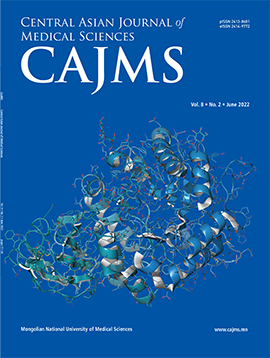Randomized Controlled Trial Comparing Standard Triple and Sequential Regimens for Helicobacter pylori Eradication
DOI:
https://doi.org/10.24079/cajms.2016.02.008Keywords:
Helicobacter pylori, Disease EradicationAbstract
Objectives: The aim of this study was to compare effectiveness of sequential therapy to the standard triple therapy to eradicate Helicobacter pylori (H. pylori) in Mongolia. Methods: From September 2014 to February 2016, 140 patients with confirmed H. pylori infection (upper gastrointestinal tract (GI) endoscopy, rapid urease test, histology, H. pylori stool antigen test (HpStAg)) randomly received 10 days standard triple therapy (20 mg pantoprazole, 1 g amoxicillin, 500 mg clarithromycin, all twice daily for 10 days; STT group, n = 70), and sequential therapy (20 mg pantoprazole, 1 g amoxicillin twice daily for 5 days followed by 20 mg pantoprazole, 500 mg clarithromycin, 500 mg metronidazole twice daily for 5 days; SQT group, n = 70). Successful eradication therapy for H. pylori infection was defined as a negative HpStAg test 4 weeks after the end of eradication treatment. Results: The eradication rates by intention to treat (ITT) analysis were 71.4% (50/70) and 50% (35/70) in the STT and SQT groups, respectively (p = 0.033). The eradication rates by per-protocol (PP) analysis were 72.5% (50/69) and 51.5% (35/68) in the STT and SQT groups, respectively (p = 0.018). The adverse event rates were 7.6% (5/70) and 18.6% (13/70) in the STT and SQT groups, respectively (p = 0.043). Conclusion: The eradication rate was significantly higher in the STT group compared with the SQT group. But the eradication efficacies of both STT and SQT for H. pylori infection in Mongolia are unacceptable.
Downloads
195
Downloads
Published
How to Cite
Issue
Section
License
Copyright (c) 2016 Mongolian National University of Medical Sciences

This work is licensed under a Creative Commons Attribution-NonCommercial 4.0 International License.




